15th Annual GamerDad Unplugged Gift Guide – 2018 Edition
 Happy Holidays! Boardgaming has had a serious upsurge in the past few years, and there’s no better time to get into the hobby than an extended holiday break. As we at GamerDad have done for the past 15+ years, it’s time for an annual rundown of recent boardgames well worth your time. Nothing beats the social aspect of in-person gaming with friends. Last year’s run-down is a great list of recommended games. Here again are some great examples of boardgames to get you and your family gaming. You might not find all these titles at your local mega-mart but many can be found online or in a friendly local game store. Some may argue $50+ boardgames are expensive, but compare that to videogaming (and where multiple copies are required for multiplayer play) or heading out to the movies ($30+ for four people) and the economics of boardgaming shows their true value. Good boardgames are timeless, just as good today as they will be years in the future. They will provide many more hours of entertainment than most video games. In that vein, feel free to delve into some past year’s guides for 2016 , 2015 , 2014 , 2013 , or 2012 . For each game I’ve provided the number of players, an approximate MSRP (you might find it lower), and expected time for one game.
Happy Holidays! Boardgaming has had a serious upsurge in the past few years, and there’s no better time to get into the hobby than an extended holiday break. As we at GamerDad have done for the past 15+ years, it’s time for an annual rundown of recent boardgames well worth your time. Nothing beats the social aspect of in-person gaming with friends. Last year’s run-down is a great list of recommended games. Here again are some great examples of boardgames to get you and your family gaming. You might not find all these titles at your local mega-mart but many can be found online or in a friendly local game store. Some may argue $50+ boardgames are expensive, but compare that to videogaming (and where multiple copies are required for multiplayer play) or heading out to the movies ($30+ for four people) and the economics of boardgaming shows their true value. Good boardgames are timeless, just as good today as they will be years in the future. They will provide many more hours of entertainment than most video games. In that vein, feel free to delve into some past year’s guides for 2016 , 2015 , 2014 , 2013 , or 2012 . For each game I’ve provided the number of players, an approximate MSRP (you might find it lower), and expected time for one game.
Kid games
Games suitable for kids old enough to sit still and play, but contain enough interesting activity to entertain adults.
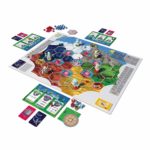 My Little Scythe (1-6 p, $50, 45-60 minutes)
My Little Scythe (1-6 p, $50, 45-60 minutes)
My Little Scythe is an extremely cute and surprisingly faithful adaptation of the very popular semi-wargame Scythe. Rather than direct combat, player move their cute little figures around the board to try and earn four trophies. These come from any number of sources such at combat, exploration, or collecting things. You can even earn a trophy for being extra nice to the other players. In the game players have the option of helping out each other to earn a “friendship” bonus. Aggressive play reduces a player’s status and if you’re too low on the friendship meter you are unable to win until you build it back up. The game even manages to preserve the idea of technologies, as players are able to upgrade their move and production actions during the game. The game is great for its age group as it stands, but it also serves as an excellent introduction to the more complex economic wargame of Scythe. Rather than simply a Scythe themed kid’s game, the game has enough similarities to its bigger sibling that it will serve as a stepping stone for younger players to move up to the full game.
 Dragon’s Breath (2-4 p, $20, 15-20 minutes)
Dragon’s Breath (2-4 p, $20, 15-20 minutes)
Winner of this year’s Kinderspiel des Jahres, is nothing if not eye catching. Consisting of a very spiffy looking column of ice in the middle filled with gems, the game centers around removing rings and betting on which colors will fall out. The top ring of ice is removed from the center of the board and then players claim any gems of their chosen color. First choice then passes to the next player, colors are declared and the next ring is removed. Rinse and repeat till all the rings are gone. Simple rules and a bit of chromatic and tactile flair make it obvious why the game has won so many awards for best children’s game.
 Kung-Fu Zoo ( 2-4p, $30, 5-10 minutes)
Kung-Fu Zoo ( 2-4p, $30, 5-10 minutes)
Kung-Fu Zoo is a dice flicking game set in arena formed by the game box insert. There is a raised edge suitable for balancing dice before flicking, and a hole in each corner. Players take turns flicking their dice at each other to either score points or eliminate each other (two game modes.) Each set of four dice are decorated in an animal pattern, showing sides, head, tail, and feet. Of course, the face-up sides of the dice matter. In elimination matches, the goal is to knock opponents’ dice down the holes or hit them so they land feet-up, making them ineligible for re-flicking. Score matches give each face a value. Scores are calculated at the end of a round, when all dice have been flicked into the ring. The four types of animals each have one special action which adds to the flavor of the game. This seemingly innocuous dice-flicking game has captivated my late-elementary aged son, and it remains one of his go-to games for playing with dad.
Party Games
The more, the merrier! Party games can accommodate at least 6 players and, unlike some games, tend to be more fun with more players.
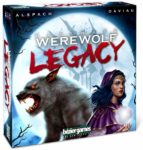 Ultimate Werewolf Legacy (8-16 p, $60, 60 minutes)
Ultimate Werewolf Legacy (8-16 p, $60, 60 minutes)
Werewolf (sometimes called Mafia) is a party game where players are assigned secret roles and the goal is for all the villagers to figure out the identities of the werewolves. Each “night” the werewolves eliminate a player and then the next “day” players debate and then eliminate a player who they believe is a werewolf. Villagers win if all the wolves are eliminated. In most professionally developed versions, a large number of roles are available granting special powers (being able to secretly see someone’s role card, avoiding death by werewolves, etc…) The “Legacy” aspect comes in here in that each play of the game will change all future plays. New roles appear and are removed, “artifacts” can be found and lost, all depending on players’ decisions from game to game. Records are kept in a cool little dossier to track changes and new features as the game gets repeat plays. In this way, as the game is played it will develop into a version unique to that group.
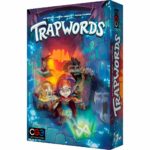 Trapwords (4-8 p, $20, 30-45 minutes)
Trapwords (4-8 p, $20, 30-45 minutes)
Trapwords is a sort of Charades or Outburst, but where the opposing team gets to choose the words a clue giver may not use. The clue giver must get their team to say the target word, without even knowing the list of unusable words! If the target word is guessed before any of the secret trap words are used (also limited either by a timer or by 5 guesses), the team can advance their scoring marker. As play progresses, clue givers get more constrained (more “traps” set, additional silly things like playing with your eyes shut, etc…) as a mild way to help the losing team to catch up.
 Decrypto (3-8 p, $20, 15-45 minutes)
Decrypto (3-8 p, $20, 15-45 minutes)
Another clue-giving party game, Decrypto allows both the clue giver and their team to know the set of four target words. The clue giver must give out four one-word clues to their team such that the team can place the target words into the correct sequence. (Such as 1-4-3-2.) The other team records the clues and the resulting sequence. This repeats over several rounds, but the target words never change. Thus, the opposing team slowly gains information about the target words from the list of clues given out. If the opposing team is able to guess the sequence responding to the clue giver’s hints, they steal the point. If a team’s guessers choose the wrong sequence they lose a point. Play continues until a team steals three sequences or misses their guess three times.
Bonus: The game Railroad Ink is a great family game but can be played by 12 or more people simultaneously, so deserves a special mention as a possible party game. See the Family Games category for a description.
Family Games
As your family gets older, they’ll have more fun with games with a bit more “punch”. Games in this category are playable by most any age level (so even the young ones can participate) but have enough strategy so that the older players have a chance to use strategy to increase their chances of winning.
 Railroad Ink (1-6 p, $20, 20-30 minutes)
Railroad Ink (1-6 p, $20, 20-30 minutes)
Railroad Ink is a roll-and-write game where one player rolls four dice and then all players use the symbols shown on the dice to draw in roads and train tracks on their personal 7×7 grid. Every round, players must incorporate the top face of all four dice. The goal is to score points by linking specific locations, forming continuous roads or train tracks, and filling in the center of the board. Meanwhile, players must try to avoid leaving any “dangling ends” which will score negative points at the end of the game. Play continues over 7 rounds, and players also have the option of using up to three additional “special” tiles during the game that allow one to link four ends at once in a + shape. The game comes in two colors (Red and Blue), each with enough materials for 6 players. Thus, owing both games would allow one to play with up to 12 people at once. (Not hard to do since everyone uses the same dice each round.) The two colors each contain a pair of “expansions” consisting of two colored dice rolled simultaneously with the others. One is not usually required to use the colored dice on a round, but they are often beneficial. The Blue version has lakes (for area scoring) and rivers (additional routes) while the Red version has meteors (which punch holes in the map) and lava (which eats up one’s board.) I highly recommend it as a game that is simple to explain, easy to play, and keeps all players active at the same time.
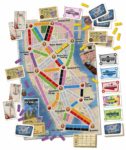 Ticket to Ride: New York (2-4 p, $20, 10-15 minutes)
Ticket to Ride: New York (2-4 p, $20, 10-15 minutes)
Ticket to Ride is one of the most-recommended games for introductory boardgamers. There are different versions and maps available, but the new New York version is an attempt to boild the game down to a short, quick game. As with all Ticket to Ride games, players draw colored cards and save them up as sets (like rummy) which are then laid down on the game board to connect cities. Players have goal cards (tickets) that score points if they are completed by the end of the game. Points are also scored for each train placed as well as connecting to specific high-traffic locations on the board. TtR: New York serves double duty as a fast-playing version of the original, but also as a great introduction to the idea that maintains much of the depth of the larger and longer versions.
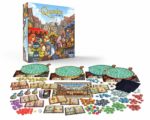 The Quacks of Quedlinburg (2-4 p, $55, 45 minutes)
The Quacks of Quedlinburg (2-4 p, $55, 45 minutes)
Winner of the pretigeous Game of the Year in Germany, The Quacks of Quedlinburg is a push-your-luck game where players are hucksters trying to sell their potions to the townsfolk. In a push your luck method, players draft ingredients into their cauldron to use in making potions that can award victory points or upgrade one’s potion making abilities. As the game progresses, players get access to better ingredients (you can buy two new ingredients per round.) Players gain money and victory points when they decide to stop pulling ingredients from their bag. If they bust, a player gains either choice, but not both. Players who are behind in scoring get a little “boost” at the start of each round as they have a few bonus ingredients starting in their cauldron.
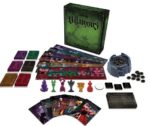 Disney Villainous (2-6 p, $40, 50 minutes)
Disney Villainous (2-6 p, $40, 50 minutes)
Extremely popular all fall, Disney’s Villainous has continuously flown off shelves. I believe that is due to the wonderful way the game has captured the theme and the story of being a villain in a Disney film. Each player is assigned a villian from one of the movies (Jafar, the Sea Witch, the Queen of Hearts, etc..) and must accomplish objectives specific to their character. The story comes in through each player’s deck of cards. Every villain has their own their own play area and their own decks of cards. For example, Jafar might need to find the lamp, unlock the cave, find the genie, and hypnotize the genie to win the game. Players’ villain decks have all the cards they need to win the game. However, a common Fate deck can be used to mess with each other. Even messing with each other can be thematic. For example, the Queen of Hearts has an ability that can enlarge or shrink a hero card, making it better (for her) or worse (for another.) There are eight possible actions on a turn. Gain power (resources to play cards), play a card, activate an item or ally, use a Fate card (the central deck you can use to mess with other people), move an ally/item/hero to another location, vanquish (an objective I think), or discard cards. Draw back up to 4 cards at the end of your turn. As I mentioned, it carries off the Disney theme very well. It isn’t a little kid’s game (there’s strategy and definately aggressive gameplay), it’s a middleweight game of trying to be the best villain you can be, while simultaneously messing around with all the other villains.
Family Strategy
These are great games for most families – or a group of adults looking for a medium-weight game to play casually around the table to end an evening. These are a notch up in complexity kid’s or party games, but are simple enough for teens or preteens to enjoy.
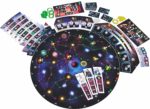 Pulsar 2849 (2-4 p, $60, 60-90 minutes)
Pulsar 2849 (2-4 p, $60, 60-90 minutes)
Pulsar 2849 is very much a points-salad type game (where you can earn victory points in many different ways) where players draft dice for actions, and it is fairly low on the direct player interaction scale. High value dice are more powerful, but they also send one’s markers lower on the turn order and the income track, whereas lower numbered dice move them upwards. It’s a pretty tight game with players making around 20 actions total in any given game. You’re moving your ship around the board, placing markers to tag planets with your stations. Meanwhile you can explore pulsars and exploit them to gain a source of ongoing victory points. Other players may focus on transmitters, a form of technology abilities which (after use) can also grant a player with a bonus action. The game is highly configurable as each game uses 3 (of 12) special scoring tiles and a set of 6 double-sided tiles consisting of the available upgrades in a particular game. Oh, and players can also choose to start the game with one of two different setups, each favoring development or movement around the board. Its most unique aspect is the players’ management of their locations on the two tracks. Sometimes it’s worth going backwards on a track to get a high numbered die, and other times it’s best to pick a low numbered die just to move forwards on a track.
 Raids (2-4 p, $40, 40 minutes)
Raids (2-4 p, $40, 40 minutes)
Raids is a game of pirates sailing around the board and collecting things. Players stop in different locations and upgrade their ships. Players earn points by killing monsters, collecting sets of runes, and earning bonus points for being the first to reach a condition or having the most of something at the end of a round. Players can upgrade their ships to hold more axes (for fighting), sails (allow more crew), goods (which can be sold for victory points, but only if the player also buys a harbor.) It is a nice light-to-middleweight game with good bits and a strong (if pirate) theme based around ship improvement. There is some aggression (you can kick out another player from a location) but it costs resources and doesn’t harm the other player very much. It’s a solid title with options, upgrades, mild aggression with a strong pirate theme.
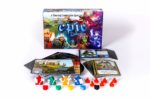 Tiny Epic Defenders (1-4 p, $30, 30-60 minutes)
Tiny Epic Defenders (1-4 p, $30, 30-60 minutes)
Tiny Epic Defenders is the cooperative title in the “Tiny Epic” line of small box games. A game board is laid out consisting of a ring of cards with an inner card representing the capital. Players move their figures around the “board” in an attempt to prevent attacks by event cards. Each location grants a special ability to a present character. Typically, characters are running around putting out fires and, at times, taking damage to mitigate long-term event consequences. More and more monsters appear on event cards until a final “boss” is revealed and a showdown occurs between the characters and the boss. The game has been revised into a second edition which is far more streamlined (and has cute little weapons for the figures) and gives the game a better story arc. An expansion, The Dark War was just released which brings in more of everything (characters, villains, regions, etc…) and a mechanic where caravans are spread around the board who must be rescued and brought back safely. The expansion also introduces a campaign mode where several games can be linked and characters can gain skills between games.
 Lost Cities: Rivals (2-4 p, $15, 40 minutes)
Lost Cities: Rivals (2-4 p, $15, 40 minutes)
This is a card-based remake of the Lost Cities card game, one of the most recommended two player games out there. Rather than drawing cards from a deck or discard (like rummy) this version has players drawing cards from one of four piles. Players either add to the display of cards or put one of the stacks up for auction. The winning bid may discard one of the cards in the pile and then may play any number of the stack into their play area. The goal is to place cards in a suit from lowest to highest to score points. There are also doubling cards present that increase one’s score if played before starting into numbers. Points are scored based on the number of footprints on the card, 1 footprint on the cards numbered 2-5 (which have two copies per color) and two footprints for cards numbered 6-10 (which are unique in each color.) There is no penalty for starting a column, but there is a bonus for columns of four or more tiles. Players begin the game with a few coins and spend them in the auctions, with only the winner paying for the cards. When the draw pile of tiles run out the discards are reshuffled and any coins spent that round are redistributed (only the spent ones, so one can hoard coins from previous rounds.) I like how it adds a bit of give and take (you can discard a tile your opponent really needs) to the standard two player game, but while the four player game is fun I find it a bit too chaotic for my taste.
Serious Strategy Games
I typically mention a few games for the more serious boardgamer. These have a few more rules and take a bit longer to play. In a year of contrasts I’m featuring one fully cooperative game and two all-out wargames. None are as complex as past years’ serious strategy recommendations, but best played by people willing to put up with a few rules in order to find a game that has substance.
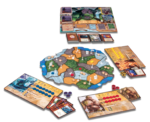 Spirit Island (1-4 p, $80, 90-120 minutes)
Spirit Island (1-4 p, $80, 90-120 minutes)
Spirit Island is currently my favorite cooperative game. It takes almost all my favorite mechanics (cooperative play, deckbuilding, building up power throughout the game, asymmetric player abilities, and huge variety of game setup options) and packs them into one game. The story sets players as spirits preserving an island from the encroachment of colonists. Spirits use their abilities as well as the original island inhabitants to try to kick out the colonists. Throughout the game the colonists appear, build towns, and then build cities becoming ever more difficult to kick out. Meanwhile, the players use play their hand of cards to activate abilities and special powers. Each player has their own unique character complete with starting cards and a player board. Each different character even has their own play style. Players must manage their hand of cards but also manage development of their player board to increase both the number of cards they can draw and the number they can afford to play. The game features simultaneous play, in that the players all act at the same time and then the colonists grow and/or respond. This keeps everyone in the game all the time, since they’re all figuring out their turns at the same time. It can be a brain burner at times, but this also makes sure there isn’t an issue of someone quarterbacking the entire game (when one player tells everyone what to do in a cooperative game) since there is just too much there for one person to monitor it all. Highly recommended, but again best for gamers willing to put up with the complexity of many possible card and ability interactions. For those in the target audience, the multitude of customization options should keep it fresh for some time to come.
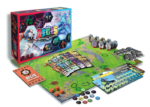 A.E.G.I.S.: Combining Robot Strategy Game (2-6 p, $50, 20-120 minutes)
A.E.G.I.S.: Combining Robot Strategy Game (2-6 p, $50, 20-120 minutes)
his “robot combat on a hex grid” has many of the typical features of this genre: terrain, various game modes (2v2, free for all, territory control, etc…), and dice for combat resolution. The “schtick” of the game comes in the name. The robots come in five flavors (Assault – offence, Evade – mobile, Guard – healthy, Intel – control/debuff, and Support – support/buff) – see what we did there with the first initials? Each robot is represented with a card that displays their powers and abilities, BUT during the game (or even beforehand) you can do a little Voltron-esque move to combine your robots into one robot. For example, you might end up with an AE or a IS robot. They can combine again and again (if you want) all the way up to a full AEGIS robot. Between the basic types and the combinations, there are 100 unique robots (with their card showing abilities, etc…) in the game. Since it is almost more of a game system than a set game, there are a multitude of available scenarios for play. Introductory ones can be played fairly quickly (to learn the game) while larger pitched battles will take the better part of an afternoon. Definitely a good fit for the tween crowd looking for a battle game.
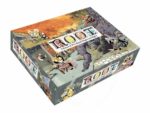 Root (2-4 p, $60, 60-90 minutes)
Root (2-4 p, $60, 60-90 minutes)
Root is a bit of a strange bird. It is at its heart a type of wargame, but its setting and style makes it quite unique. Players take on the role of a specific clan of animals and battle for control of the wilderness. The big selling point of the game is in its asymmetric gameplay. Each clan of animals have wildly different powers, styles of play, and even different winning conditions. The Cats are trying to build up production, birds try to capture territory, the Alliance skulks around trying to build up for a big end-game, and the Vagabonds sort of play each clan off each other while also working on their own hidden agenda. It’s strength, the unique sides, are also its weakness. Each side plays very differently and it is easy for one player to lose site of what the others are doing or at least how far along they are to their final goal. The first few games will require players to explore the various sides, with further adjustments and strategies arising with repeated play.
 Axis & Allies & Zombies (2-5 p, $40, 60-180 minutes)
Axis & Allies & Zombies (2-5 p, $40, 60-180 minutes)
Yes, another Axis & Allies game, but one I did not see coming. Axis & Allies & Zombies puts a new spin on the standard WWII wargame. It begins with the standard gameplay where the three Allies (US, UK, Russia) fight the Axis (Germany, Japan) for control of the world. Players use their pieces to capture territories which provide income. Income is used to purchase new units for further attacks. My favorite part of the franchise is how players are free to pursue their own style of game. Infantry is cheap but not effective on offence, while planes are more mobile and strong combatants but expensive. The key is to balance the two so that your best units are attacking while you serve up your poor infantry to soak up any returning fire. The game is much as before, but zombies are now added to the mix. Any time an infantry is defeated, it returns as a zombie unit. These attack less often but are completely indiscriminate in their attacks. There is also a mechanic to allow zombies to pop up anywhere on the board, making sure there is no safe “behind the lines” area. The game’s appeal lies in its theme. The addition of zombies adds more randomness to the mix (there are even anti-zombie technologies you can gain) which is great for mixing up traditional Axis & Allies strategies (no longer does someone conquer Africa with a single tank and infantry) but also makes an already dice-heavy game even more swingy even if dice rolls tend to even out over time. As a game similar in scope and complexity to the standard game, Axis & Allies & Zombies delivers on its name, so if the title intrigues you it is probably worth a look.
Expansions
If you already have favorite games in your collection, you may be pleasantly surprised to find there are expansions available to breathe new life into old favorites. The Exit: The Game series ($15 each ) continues with more “escape room in a box” opportunities. I’m always impressed at how many unique puzzles they can cram into a box of cards. Codenames: Harry Potter offers up a new theme for the two-player clue-passing game. The compact (and inexpensive) deckbuilder Star Realms: Frontiers is the new edition of the compact (and inexpensive) sci-fi deckbuilder. The new stand-alone expansion includes double-ally cards that key off the play of two similar cards (rather than just one.) What sets it apart for me is the inclusion Mission cards that provide one or more players with a cooperative version of the game. Players each control their own deck and fight against a card-programmed antagonist “boss”. Each of the eight different Mission cards has their own style of play, requiring players to adjust their strategies. The Captain is Dead: Lockdown is a sequel to the hilarious cooperative spoof of life on a Star Trek ship. Players are now stuck in prison and must escape past the security system and the guards. Player death is more frequent in this version, but players spawn back in using a new character of a similar color. Losing all your characters ends the game. My favorite kids’ cooperative boardgame, Ghost Fightin Treasure Hunters has a new Creepy Cellar Expansion. It expands the board, requiring players to move all the gems into the basement. It also introduces cursed gems and other problems, which are somewhat offset by the rewards provided whenever a gem is successfully delivered. Finally, if you’re a Catan fan, the Catan Histories: Rise of the Inkas is now out and has players playing in a long, narrow board sandwiched between the sea and the jungle. Commodities from the ocean and the jungle are more “efficient” sort of like using particularly good ports. Rather than a VP goal, players are trying to lead their civilization through three distinct phases. The first player to reach all three phases, wins. Things like “longest road” instead provides development cards. Watch out for that jungle, though as settlements can be overgrown during the game.
Stocking Stuffers
Got a bit of space left in your sock over the fireplace? Here’s a great small game that you might be able to cram into the toe…
 The Mind (2-4 p, $15, 15 minutes)
The Mind (2-4 p, $15, 15 minutes)
My most-played game of the year, it is a cooperative game unlike anything you’ve played before. Players are dealt a hand of cards (one the first round, two the next, etc…) numbered from 1 to 100. Then, WITHOUT TALKING! players need to place their cards down on the table in order from the lowest to highest. It seems like an impossible task, but as players begin to feel each other out and players start to “gel” you can see amazing plays where three players manage to play a 31, 34, and 35 all in the correct order (without talking!) It isn’t a game for everyone, but those who do like it almost universally love it.
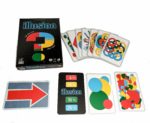 Illusion (2-5 p, $15, 15 minutes)
Illusion (2-5 p, $15, 15 minutes)
Illusion has players trying to compare a color’s coverage on a card. The deck of cards consist of “optical illusions” that use four different colors. Each round a color is chosen and then players take turns flipping up a card and placing it in the tableau such that the line of cards is lined up from least to most area of that color. Players can either flip and place a card or challenge a previous placing. A simple game that is easy to teach (unless you’re colorblind – sorry) and doesn’t require deep strategy or even reading ability. A great candidate game for those families with a wide age range.
Conclusions
No matter what toys and presents the holidays bring, be sure to keep time in your schedule for playing with friends and family. While the games here come highly recommended to provide fun for a wide range of players, there are plenty other choices available. Ask your local game store, a boardgaming friend, or check some of our past recommendations.





Discussion Area - Leave a Comment